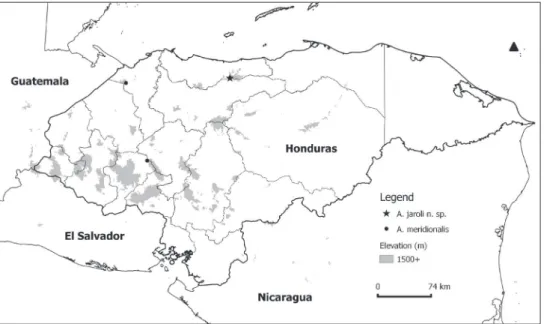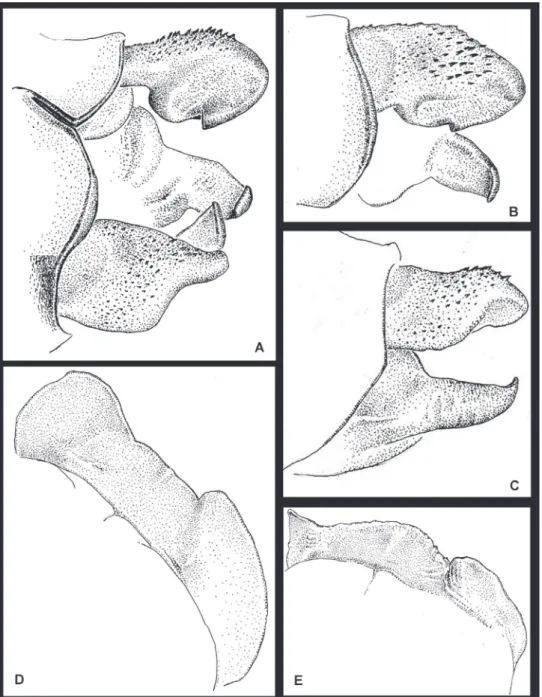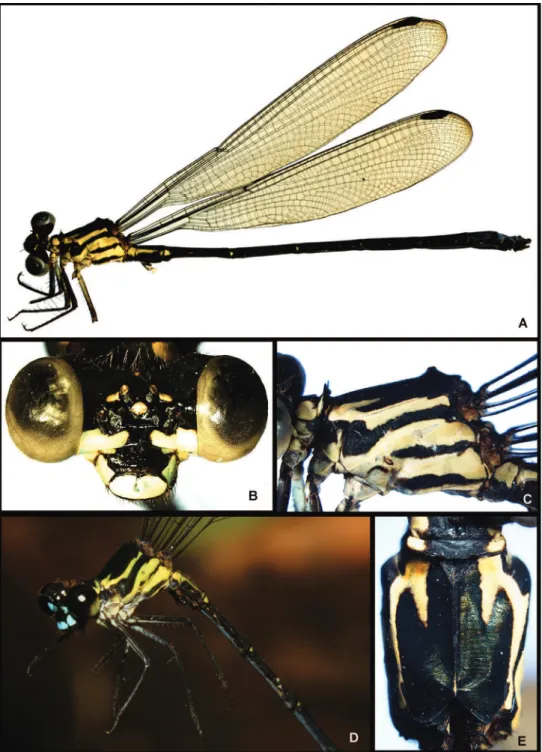A new species in the genus Amphipteryx Selys, 1853
(Odonata, Amphipterygidae) from Pico Bonito
National Park, Honduras
Merlijn Jocque1,2,3,†, Ivany Argueta2,4,‡
1 Jessica Ware Lab, Rutgers, the State University of New Jersey, 195 University Ave, Newark, NJ, 07102, USA
2 Royal Belgian Institute of Natural Sciences (RBINS), Vautierstraat 29, 1000 Brussels, Belgium 3 Biodiver-sity Inventory for Conservation (BINCO), Rijmenamsesteenweg 189, Haacht, Belgium 4 Instituto Nacional de Conservación y Desarrollo Forestal, Áreas Protegidas y Vida Silvestre (ICF), Oicina Regional Forestal del Atlántico, Col. Palmira, La Ceiba, Honduras.
† http://zoobank.org/6F4C1B5C-BDD9-4217-8F29-95ADA5E9F4D3
‡ http://zoobank.org/F479B56F-A0ED-47D4-BF15-26FA08272C87
Corresponding author:Merlijn Jocque (merlijnjocque@gmail.com)
Academic editor:N. von Ellenrieder | Received 1 February 2014 | Accepted 23 April 2014 | Published 13 May 2014 http://zoobank.org/5F8139EC-37FE-4395-A8F5-20DEE9EAAABD
Citation: Jocque M, Argueta I (2014) A new species in the genus Amphipteryx Selys, 1853 (Odonata, Amphipterygidae) from Pico Bonito National Park, Honduras. ZooKeys 408: 71–80. doi: 10.3897/zookeys.408.7174
Abstract
he Mesoamerican damselly genus Amphipteryx includes four species: Amphipteryx agrioides (Mexico),
A. chiapensis (Mexico), A. meridionalis (Honduras) and A. nataliae (Verapaz, Guatemala). We describe a ifth species, Amphipteryx jaroli, from the cloud forest in Pico Bonito National park, Honduras. Additionally we include an up to date key of all species in the genus for both sexes.
Resumen
El género Mesoamericano del zigóptero Amphipteryx incluye cuatro especies: Amphipteryx agrioides, (Mexico), A. chiapensis (Mexico), A. meridionalis (Honduras) y A. nataliae (Verapaz, Guatemala). Se de-scribe una quinta especie, Amphyterix jaroli, localizada en ul bosque nublado del Parque Nacional Pico Bonito, Honduras. Adicionalmente se incluye una clave actualizada de todas las especies del género, tanto para machos como hembras.
www.zookeys.org
Copyright M. Jocque, I. Argueta. This is an open access article distributed under the terms of the Creative Commons Attribution License (CC BY 4.0),
which permits unrestricted use, distribution, and reproduction in any medium, provided the original author and source are credited.
Keywords
Zygoptera, cloud forest
Introduction
Central American cloud forests habitats are critically endangered ecosystems disap-pearing rapidly (Solorzano et al. 2003). While an estimated 80% of original lowland forest vegetation cover has already been lost or modiied (Brooks et al. 2002), these hilltop and ridge forests have remained untouched for a long time, mostly due to diicult access. he growing pressure on remaining natural resources associated with increasing population now is also afecting cloud forests. he diicult access, once a protective trait, now works against an eicient conservation as it hampers data collec-tion. Relatively little is known on the biodiversity in these habitats, but cloud forests are characterised by a high diversity and high endemicity. A recent overview of the 100 most irreplaceable places for biodiversity in the world (Saout et al. 2013) included the cloud forest in Pico Bonito National Park.
During a biodiversity survey of cloud forest in La Montaña de Corazal (Pico Bonito National Park) we discovered a new species of Amphipteryx. he genus Am-phipteryx belongs to the monotypic family Amphypterygidae (Dijkstra et al. 2013). he two latest overviews of the species in this genus (González-Soriano and von El-lenrieder 2009; González-Soriano 2010) present illustrations and a key to all known species. he species from Pico Bonito NP has a close resemblance to A. meridionalis, the only other Amphipteryx currently recorded from Honduras. he new species dif-fers by the bilobed lamellate processes on the prothorax. Here we describe this new species of Amphipteryx and update the keys for the separation of all species within the genus.
Materials and methods
Results
Amphipteryx Selys, 1853
http://species-id.net/wiki/Amphipteryx
Amphipteryx Selys 1853: 66.
Type species.Amphipteryxagrioides Selys 1853, by original designation.
Other species included. Amphipteryx chiapensis González–Soriano 2010, A.
me-ridionalis González-Soriano 2010, A. nataliae González-Soriano 2010.
General. Amphipteryx is the only genus in Amphipterygidae (Dijkstra et al. 2013).
Rimanella, with its monotypic species R. arcana (Needham 1933), was formally in-cluded in Amphipterygidae but it was recently placed in its own monotypic family Rimanellidae (Dijkstra et al. 2013).
Distribution. Amphipteryx occurs at small mountain streams from Hidalgo
Oax-aca, Puebla and Veracruz States, Mexico east into Guatemala and Honduras.
Biology. Adults perch with wings closed on vegetation overhanging water near
seepages and small streams (González-Soriano 1991); larvae live in rough gravel and rapid-low areas of small shallow creeks, and among leaf litter at lips of small waterfalls (Novelo-Gutiérrez 1995). With one exception (below) all Mexican populations are associated with tropical wet forests (i. e. cloud or tropical rain forests) and the same apparently is true for other Central American populations.
Key to males of Amphipteryx
his key is a modiication of the one from González-Soriano (2010) and reference should be made to illustrations for other species in that paper.
1 Hind lobe of prothorax evenly curved with small disjunct lateral lobes form-ing small rounded lobes whose medial margins are bent anteriorly; cercus in dorsal view curved medially and armed with a blunt quadrate lobe along medial 0.40; paraproct slender, slightly surpassing cercus and with medi-ally curved tip terminating in a single tooth; Hidalgo and Oaxaca States, Mexico ...A. agrioides
1’ Hind lobe of prothorax with erect digit-like lateral lobes, or with middle lobe bent cephalad or posteriorly (Fig. 2D); cercus in dorsal view linear and lacking a blunt quadrate lobe along medial 0.40, paraproct dorso-ventrally lattened, as long as or considerably shorter than cercus and terminating in an angular to quadrate tip; Chiapas State, Mexico, Honduras and Guatemala ...2
2(1’) Hind lobe of prothorax continuous; raised lateral lobes vertical, semicircular, and continuous with smaller irregular shaped middle lobe; Honduras ...3
3(2) Scalariform tooth on cercus in mediodorsal view anteapical, medial margin of cercus gently concave; middle lobe of hind lobe of prothorax bilobed or with a v-shaped incision medially, bent cephalad, this structure as prominent as lateral lobes; Comayagua and Cortés Departments, Honduras ...A. meridionalis
3’ Scalariform tooth on cercus in mediodorsal view at medial half, medial margin of cercus with ventro-medial lobe at basal third (Fig. 2A); middle lobe of hind lobe of prothorax entire, bent posteriorly and much smaller than erect wing-like lateral lobes (Fig. 2D); Atlantida Department, Honduras ...A. jaroli
4(2’) Paraproct as long as cercus and terminating in an angular tip; erect lateral lobes of prothorax as long as interval between them; Guatemala ...A. nataliae
4’ Paraproct considerably shorter than cercus and terminating in a quadrate tip; erect lateral lobes of prothorax much shorter than interval between them; Chiapas State, Mexico ...A. chiapensis
Key to females of Amphipteryx (female of A. chiapensis unknown)
1 Hind lobe of prothorax evenly curved with lateral lobes forming small angulate lobes; Hidalgo and Oaxaca States, Mexico ...A. agrioides
1’ Hind lobe of prothorax with erect digit-like lateral lobes, or with middle lobe bent cephalad or posteriorly (Fig. 2E); Chiapas State, Mexico, Honduras and Guatemala ...2
2(1’) Hind lobe of prothorax with a pair of small, isolated, erect digit-like lateral lobes converging posteriorly; Guatemala ...A. nataliae
2’ Hind lobe of prothorax with erect lateral lobes continuous with middle lobe; Honduras ... 3
3(2’) Middle lobe of hind lobe of prothorax bilobed or with a v-shaped incision medially, bent cephalad, this structure as prominent as lateral lobes; Comaya-gua and Cortés Departments, Honduras ...A. meridionalis
3’ Middle lobe of hind lobe of prothorax entire, bent dorso-posteriorly and sube-qual in height to erect wing-like lateral lobes (Fig. 2E); Atlantida Department, Honduras ...A. jaroli
Species description
Amphipteryx jaroli sp. n.
http://zoobank.org/DAE4DF4E-0E95-4A33-BA0C-5E02CE4EF531 http://species-id.net/wiki/Amphipteryx_jaroli
Figs 2A–E, 3A–E
Etymology. Named jaroli (noun in the genitive case), after our friend and guide
Type material. Total: 9 males (32.597/1-10, Coll. I.R.Sc.N.B.) and 1 female (32.597/10). Holotype: male (32.597/1), Honduras, Pico Bonito National Park., Montaña de Corazal, cloud forest, north of the small village Los Horcones in Northern Honduras. Basecamp was at 1640m (N15.556, W86.918), all collections were made in the vicinity from this location.
Description. Holotype dimensions: Fw 39,0mm; Hw 36,0mm; abdomen
46,0mm; total length 51,0mm . Head of male holotype with basal part of labium light cyan blue (Fig. 3D), labial palp and apex of mentum black, labrum and gena light cyan blue, mandible black except for well-deined pale yellow spot at base, large spot conlu-ent with the genae on either side of antefrons, light cyan blue (Fig. 3A, C–D). Clypeus and midline of antefrons black, and most of the dorsal and posterior surfaces of the head, black, lateral area of antefrons light cyan blue; anterior portion of epicranium to epicranial furrow shiny black except for a small elongated yellow patch extending antero-laterally from each lateral ocellus (Fig. 3B); posterior portion of epicranium including postocular lobes, occipital bar, and rear of head matte black.
Prothorax black except for pale yellow anterior lobe and large lateral spot on either side of median lobe and below ventral margin of propleural suture (Fig. 3A, C–D); hind lobe (Figs 2D, 3A, C) with paired dorsal, upright, lamellate processes, which, in lateral view (Fig. 3C) are thin, and strongly erect, each anteriorly with pale yellow patch on distal half; distance between these lobes about twice the height of each lobe, middle lobe decumbent dorso-posteriorly and not as high as lateral lobes. Synthorax yellow green (Fig. 3A, C–D) with a broad mid-dorsal black stripe conluent with ab-breviated broad black antehumeral stripe at upper half, its ventral portion acuminate, and not reaching mesinfraepisternum; this last with anterior half black, posterior half pale yellow green; side of thorax yellow green with three narrow lateral black stripes; one on middle of mesepimeron with its ventral portion expanding to mesinfraepister-num, its upper end along margin of antealar crest and meeting second (interpleural) stripe at upper posterior margin of metepimeron and ending antero-ventrally above metastigma; third thoracic stripe extending full length of posterior margin of me-tepimeron; venter of thorax pale. Coxae pale yellow washed with darker brown ven-trally; legs blackish with bases and the inner, surfaces of the femora yellowish; armature and claws black. Wings hyaline; Ax Fw 8:9; Hw 8:8; Px Fw 31:28; Hw 23:27.
Figure 1. Occurrence records of the two species of Amphipteryx found in Honduras. Arrow indicates the North.
to base with a large robust ventro-medially directed lobe (Fig. 2A); medial surface from tooth to apex smooth, slightly convex; in lateral view cercus linear, with ventral surface dorsally arched exposing inner margin of tip of cercus (Fig. 2A). Paraproct subequal to cercus, its tip in lateral view directed dorsally (Fig. 2B), base in dorsal view inlated, paraproct tapering down, apex with quadrate tip pointing medio-dorsally (Fig. 2A, C).
Variation in paratypes. Males difer in extent of black on body and in shape of
pronotal lobes. he narrow mesepimeral stripe in some is complete and connects with black ventrally on mesinfraepisternum, interpleural stripe may be broken into elongate spots and third thoracic stripe may be reduced. Normally the pronotal lobes are pale, but the size of this patch varies in some specimens, height and morphology of the pronotal lobes is also variable. In some animals the normally erect lobes gently dip anteriorly when viewed laterally. In one male, wings were slightly infumed.
Female similar to male but black markings on head, pro- and especially on syntho-rax reduced. Mid-dorsal black stripe narrower than in male, occupying less than 0.25 of each mesepisternum, asymmetrical hourglass pattern, with the narrowest part anterior, steadily widening posteriorly, ventral acuminate portion isolated, only attached to mid dorsal stripe through a narrow black line at the edge of the pterothorax, in dorsal view an acuminate ish hook shape, extends less than half length of mesepisternum. Pronotal lobes smaller and less pronounced compared to male.
Dimensions. Males (n = 25, including holotype; means in parentheses): Hw
Figure 2. Amphipteryx jaroli (A–E), S10 holotype male dorso-lateral (A), ventro-lateral (B) and lateral (C) view. Holotype male posterior lobe of prothorax (D) and female posterior lobe of prothorax (E).
Distribution. Currently only known from Pico Bonito National Park, Honduras
Diagnosis. he structure of the pronotal lobes in lateral view, with the two large, straight lobes, separates this species from other species in the genus. Additionally, the male is separable based on the position of the well-developed scalariform tooth on the internal side of the cercus approximately halfway between apex and base. Amphipteryx chiapensis, A. meridionalis and A. nataliae have a well-developed scalariform anteapical tooth, A. agrioides has the scalariform tooth positioned more basally, but still closest to the apex (González-Soriano and von Ellenrieder 2009).
Discussion
he narrow elevational distribution of Amphipteryx jaroli is remarkable. he expedi-tion departed from Los Horcones, a small village at an elevaexpedi-tion of 289m, cross-ing the forest on a three day hike to a provisionary basecamp at an elevation of 1640masl. From basecamp daily excursions in all directions were completed and dragonlies collected. Despite the substantial altitudinal range crossed, this species was only collected from a narrow elevational range. Other Amphipteryx species are also cloud forest species as a rule occurring at mid-height elevation around medium sized rocky mountain rivers. A single A. agrioides was collected at 36m, but this seems to be an exception. Amphipteryx agrioides has been found as low as 650m in Pueblo State, Mexico.
Acknowledgments
We thank Rosser Garrison for his endless support and guidance on our irst steps in the dragonly world and most of all for the illustrations and images of the holotype that accom-pany this paper. hanks also to Tim van Berkel for his enthusiasm and dedication during the expedition. Many thanks to Don Eduardo Cardoza, Rene Ordoñez, Don Faustino Del Cid, Maria Montufar for support in the ield. MJ was supported by a “Back to Belgium” grant from the Belgian Science Policy (BELSPO) issued in 2010 and the Ralph Brown Award issued by the Royal Geographic Society in 2013.
References
Brooks M, Mittermeier RA, Mittermeier CG, da Fonseca GAB, Rylands AB, Konstant WR, Flick P, Pilgrim J, Oldield S, Magin G, Hilton-Taylor C (2002) Habitat loss and extinction in the hotspots of biodiversity. Conservation Biology 16: 909–92. doi: 10.1046/j.1523-1739.2002.00530.x
González-Soriano E (1991) A new species of Amphipteryx Selys, 1853 from Oaxaca, Mexico (Zygoptera: Amphipterygidae). Odonatologica 20: 465–470.
González-Soriano E, von Ellenrieder N (2009) What is Amphipteryx agrioides Selys 1853 (Odonata: Amphipterygidae)? Zootaxa 2074: 61–64.
González-Soriano E (2010) A synopsis of the genus Amphipteryx Selys 1853 (Odonata: Am-phipterygidae). Zootaxa 28: 15–28.
Novelo-Gutiérrez R (1995) he larva of Amphipteryx and a reclassiication of Amphipterygidae sensu lato, based upon the larvae (Zygoptera). Odonatologica 24: 73–87.
Saout S Le, Hofmann M, Shi Y, Hughes A (2013) Protected Areas and Efective Biodiversity Conservation. Science 342: 803–805. doi: 10.1126/science.1239268
Solorzano S, Castillo-Santiago MA, Navarrete-Guiterrez DA, Oyama K (2003) Impact of the loss of neo- tropical highland forests on the species distribution: a case study using re-splendent quetzal an endangered bird species. Biology Conservation 114 (3): 341–349. doi: 10.1016/S0006-3207(03)00054-5


